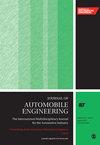Haptic tele-driving design of vehicle steering control system with communication delay under complicated driving and road conditions
IF 1.5
4区 工程技术
Q3 ENGINEERING, MECHANICAL
Proceedings of the Institution of Mechanical Engineers Part D-Journal of Automobile Engineering
Pub Date : 2024-07-26
DOI:10.1177/09544070241261111
引用次数: 0
Abstract
In this paper, stabilization of tele-driving system in presence of communication time delay is studied using a 103 DOF vehicle model generated in ADAMS/Car Software. The purpose of this study is achieving a real sense of driving for tele-driving system in virtual environment under complicated driving and road conditions. To this aim, the performance of the various control architectures, in terms of position and force tracking, are investigated. Hence, the two-channel architecture is chosen as the most appropriate scheme to implement the haptic control system for the vehicle steering mechanism. In this paper, we designed an effective haptic feedback control for vehicle steering mechanism in the tele-driving system so that a command can be exerted to steering wheel by the human operator, which passes through the communication channels and will be applied to unmanned vehicle steering system. It is verified that an appropriate coordination performance under the human input can be obtained with the proposed control framework. To overcome the possible instability problem associated with existence of time-delay in communication channels, wave variables and their corrections are effectively embedded into the control system. Finally, the proposed bilateral tele-driving control on a rough 3D road surface at complicated driving and road conditions in the presence of time-delay are examined comprehensively.复杂驾驶和道路条件下具有通信延迟的车辆转向控制系统的触觉远程驾驶设计
本文使用 ADAMS/Car 软件生成的 103 DOF 车辆模型,研究了存在通信时延情况下远程驾驶系统的稳定性。本研究的目的是在复杂的驾驶和道路条件下,在虚拟环境中实现远程驾驶系统的真实驾驶感。为此,研究了各种控制结构在位置和力跟踪方面的性能。因此,我们选择了双通道架构作为实现车辆转向机制触觉控制系统的最合适方案。在本文中,我们为远程驾驶系统中的车辆转向机构设计了一种有效的触觉反馈控制,使人类操作员可以向方向盘发出指令,该指令通过通信信道并应用于无人驾驶车辆转向系统。经过验证,所提出的控制框架可以在人类输入下获得适当的协调性能。为了克服通信信道中存在的时延可能带来的不稳定性问题,波变量及其修正被有效地嵌入到控制系统中。最后,在存在时延的复杂驾驶和道路条件下,对所提出的粗糙三维路面双边远程驾驶控制进行了全面研究。
本文章由计算机程序翻译,如有差异,请以英文原文为准。
求助全文
约1分钟内获得全文
求助全文
来源期刊

CiteScore
4.40
自引率
17.60%
发文量
263
审稿时长
3.5 months
期刊介绍:
The Journal of Automobile Engineering is an established, high quality multi-disciplinary journal which publishes the very best peer-reviewed science and engineering in the field.
 求助内容:
求助内容: 应助结果提醒方式:
应助结果提醒方式:


